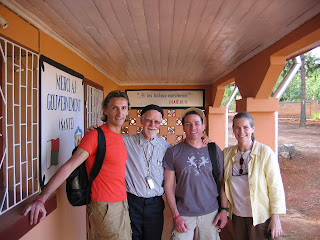12/26/2007
Najera – Santo Domingo della Calzada, Spain
Today the walk wasn’t so long, only 22 Km but all under the rain, I am in the Rioja region where the path is very muddy, and after a while is like walking with weights at my ankles. Nobody is around, last night I slept all alone in Najera as the day before in Logrono. I really hope that tonight I will meet someone at the next stop to talk with; maybe we could share a meal together or at least a glass of this great Rioja wine.
I arrived at the Rifugio of Santo Domingo and with great surprise I see other 4 pilgrims. A couple from Barcellona. a very nice German guy, Heiko, who is an actor and then there is an old guy from Madrid. I am not really sure what is the deal with him, he says he is living on the Camino, walking back and forth all alone, but when I talk to others they say that nobody has ever seen him actually walking, maybe he is a homeless and by pretending to be a pilgrim he can sleep in the refuges. I really cannot care less if this is the true or not, actually, if he is really a homeless, I commend him for having found a dignify way to get a roof on his head. He is friendly and we start talking. I offer him wine and I share my dinner that he accepted with a smile (especially for the good wine). He asks me why I do the Camino, and why I choose to come to Spain. I explain to him that this is not my first time on the Camino. And I explain to him, that although I am from Boston, I know very well Spain… Then I add that I do it also as a way to raise money for A Bridge of Roses.
with Frere Romain, Tom and Winifred in front of our project "Atelier Ponte Rosa", Madagascar
Europeans do not really understand the concept of raising money for charities. In Europe people tend to rely more on the government, they pay higher taxes and the government supports what in US it is instead often supported through personal donations, like cultural projects, education, and charities… So it took a while for me to explain him the entire project.
He listened carefully but at the end, with a very blunt comment, he replied:
“I feel you do all this as respond for felling guilt of being rich!”.
I am stunned; even from a European perspective such a blunt comment, if made by a stranger, would be considered rude. So I almost stood up and left him there with the bottle of wine, but instead I engaged him in a conversation (also I wasn’t finished with drinking my wine… J)
True is that I believe I was actually explaining to myself, more than to him, the real reasons behind my desire to found my charity.
In Madagascar giving away puppets handmade by a very good friend of mine, Katarina
- First, I replied, I am not rich. Well of course I am better off than people who live with two dollars budget a day, or people without a job or a house, or people who live in a country at war, or people who have lost everything under an earthquake… Of course I am better off than them. And I do consider myself rich, as I have a great family, a fantastic partner, a very nice life, a great job that I love and great support from my friends. So, I am not poor.
But do I feel guilty for all this? Not really.
Why should I?
I wake up every morning and work, and I try all my best to reach out to others.
Each of us has his own Camino…
I leave the feelings of guiltiness to the ones who fall asleep, and the ones who do not try to elevate themselves, the ones that are just “passing by”, and finally the ones that enough is never enough.
But if, in the small or in the big, with little or with a lot one try his best to share his own Camino with the others, if one, with all the mistakes people can make, try his best to help, to reach out… Well, I do not see why this person should have any sense of guilt.
Can I do more? YES!
Then I tell him: -“Have you seen the movie Schindler’s List? At the end Oskar Schindler says something very touching… “Look this watch, it is worth so much, I could have sold it and save two more lives, and by selling this pin: one more live, and this coat: two more… I could have done more, much more!”
Yes, I can do more. But… for the moment, this is what I can do. It is that simple. And at that point I left him there.
Unfortunately, it is not that simple… because, deeply in my heart, I know I can do more.
Tom with one of our little friends





























